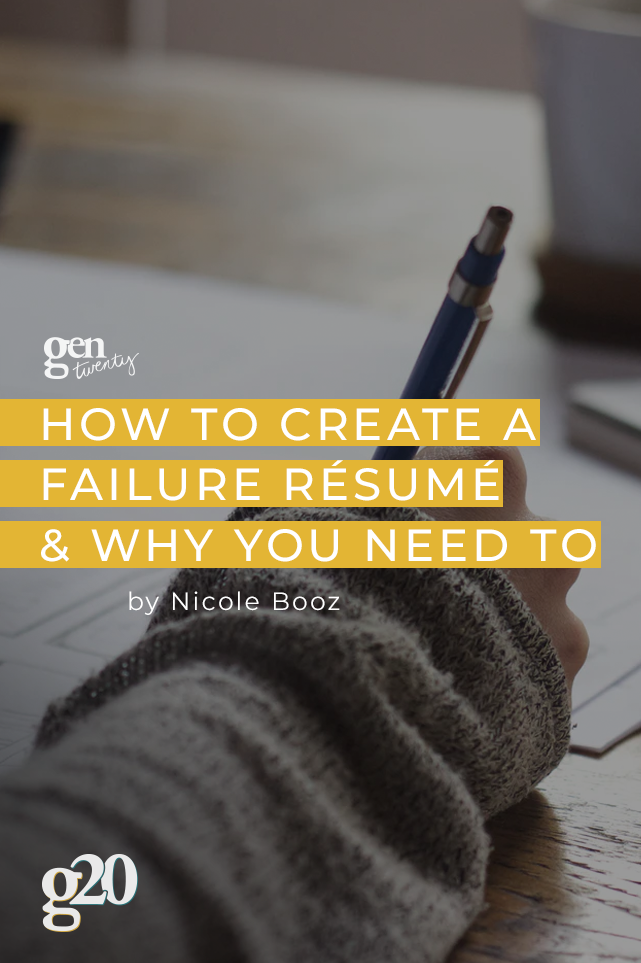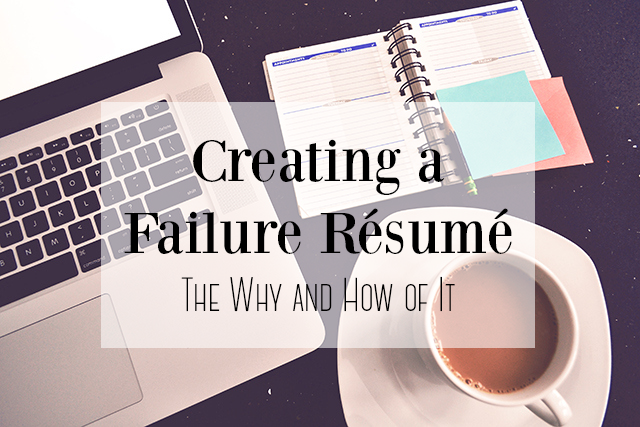Typically, we use a traditional resume (or CV) to showcase the very best of our professional history. We use our resume to show off our skills, we pepper it with appropriate action verbs to illustrate our contributions to past employers, and we attempt to paint a picture of ourselves within it to show just how perfect we are to prospective employers.
But because our resumes are meant to highlight our successes, they leave out a very important part of personal and professional growth: failure.
Failure is where change happens; Failure is where we learn life’s biggest lessons. It is in our failures that we experience the most growth. However, failure is also a source of embarrassment for many of us.
Looking at our own failures can be uncomfortable. And a professional failure can feel embarrassing. We often take it to mean that we weren’t good enough or that we didn’t try hard enough. While that may have been true at the time, it’s not the end of the story.
On the contrary, failure provides a unique opportunity for us to learn and respond. When things go well or go right the first time, we lose the opportunity to take a new approach. We lose the chance to have a different experience or gain a new perspective.
Enter the failure resume. What is it? Simply put, a failure résumé highlights all of your past failures and unsuccessful ventures. Failure is one of the essential parts and missing truths of growth. At first sight, it seems like successful people never fail, but that is simply not true. Many professionals have their own failure resume they keep track of on top of their regular resume. Failure is the best teacher, after all.
And ultimately, the path the success is not a straight line.
Glossing over your failed attempts at success will only hinder you more in the future. Dr. Melanie Stefan, a lecturer at Edinburgh Medical School, has a relatively new TED Talk on the topic as well if you’d like to watch more. She made her own, listing graduate programs she didn’t get accepted into, degrees she ultimately didn’t finish, rejections from several orchestra auditions, and even harsh feedback from a previous boss. These are just some examples of things you can list on your failure resume.
The last year may have been on of the hardest of your professional life. Any failings in the last year (personal failures included) are likely more circumstantial than anything. You are not your failures.

Why you should make a failure resume:
There are many good reasons to make a list of your career failures. And remember, you should be brutally honest when making it because it’s just for personal use. Being honest and objective can have a great impact on your success story. Failure is an important part of our learning process.
1. It will help you identify your weaknesses.
The pesky question we all dislike involves talking about our weaknesses. Interviewers are tired of hearing that your biggest weakness is your “dedication to work” because you “get so caught up in working hard that you forget to eat.” Your failure resume will aid you in determining your genuine weaknesses and additionally how you can actively work to overcome them.
When you look at your past failures, a pattern will likely start to emerge. Maybe you’re a strong self-starter but often fail to finish many of the tasks you set out to complete.
2. It will give you more examples.
One of the best ways to illustrate the things you’ve learned over your career is to provide examples. Looking at your professional history with a different perspective will help you remember things you’d forgotten about.
We all have bad days. But that doesn’t mean we are bad people or unsuccessful. It’s easy to get caught up in the false narratives in your head. You need to approach your failure resume with a practical approach. It is one of the essentials parts of growing.
3. It will teach you about failure.
We see failure as something to be avoided, and though a successful outcome is the favorable one, it doesn’t mean you cannot embrace failure as an opportunity. Getting in the habit of reframing your failures will teach you how you can be successful in the future.
Once you know these failures and weaknesses, one of the great things you can do is implement small changes in the way you present yourself to other. For example, once you know what your failures are, you can present your strengths more positively to hiring managers for future jobs.
How to create your failure resume:
First of all, make a copy of your resume.
Go through each position you’ve ever held, every school you’ve ever attended and make lists of things you wish had happened differently, things that didn’t pan out the way you intended, and things that didn’t have a favorable outcome.
It may be that you wish you had majored in Computer Science rather than Communications, or that you ended up with an ‘F’ in a math class that you never needed in the first place. Both of these things count as failures.
Take time to consider your shortcomings.
Maybe a project didn’t pan out because you rushed it, or perhaps you didn’t reach an important deadline.
Your failure resume is just for you – no one else ever needs to see it. Be brutally honest and specific when considering where you fell short.
You can include all of the degree programs you didn’t get into, every unsuccessful application, harsh feedback from co-workers or selection committees, when you didn’t get a new job, when you didn’t get the research funding or when you bombed a presentation. It all counts!
Put a positive spin on each of your failures.
After you have gone through and listed every failure you can reasonably think of, go back through and put a positive spin on each of your failures.
Here are a few examples:
1) “I wish I majored in Computer Science rather than Communications.” → “My Communications degree gave me a foundation for public relations. I can use this to show others how a degree in Computer Science is useful.” Insert public affiars or communication or graphic design — whatever the case is, it’s like you can use your current degree in the way you want.
2) “I earned an ‘F’ in math class because I wasn’t prepared for the material.” → “I wasn’t prepared for a class at this level. Next time I am unprepared for something, I will seek out ways (such as a tutor or a mentor) to make sure I understand the basics.”
3) “The first project I ever led failed because I didn’t communicate well enough.” → “My communication skills weren’t developed enough when I lead this project. I have since learned how to use the team calendar/management software to keep my team up-to-date and on task.”
4) “I didn’t turn a proposal in on time and my team lost a big contract.” → “I will never procrastinate on a proposal again. I have learned how to set mini-deadlines for myself and complete my work at least a week prior to the due date.”
Success is important, but identifying your failures is arguably a more productive way to understand the ways you’ve grown in your career. One of the biggest failures is not taking the time to learn from both our professional life and personal failures.
Even Successful People Fail
One of the most important lessons I really want you to remember is that people who we have thought of as “successful” have failed.
Think about J.K. Rowling and her terrible comments on social media. There are people at Columbia University, Princeton University, Stanford University who fall in their research consistently (and see it as a good thing).
Have you ever made a failure resume for yourself? What have you learned from your failures?
[Tweet “Here’s how to make a failure resume (and why you should):”]
This post was originally published August 2014. Updated September 2021.

